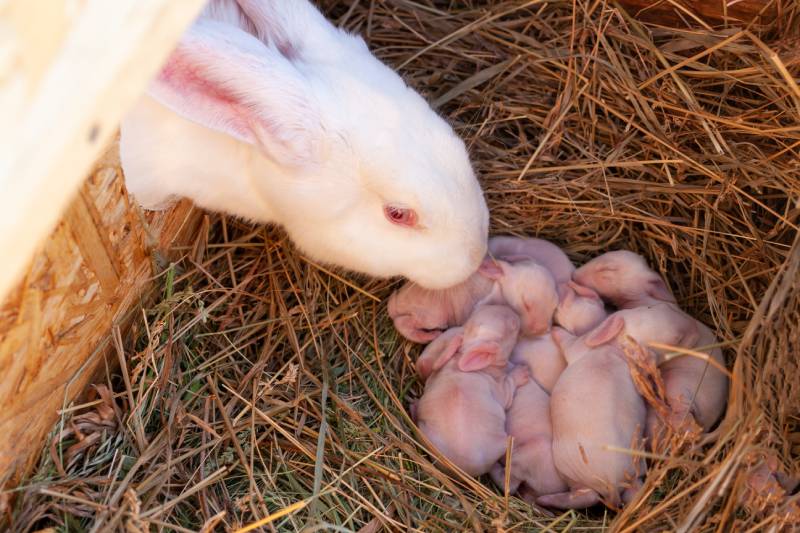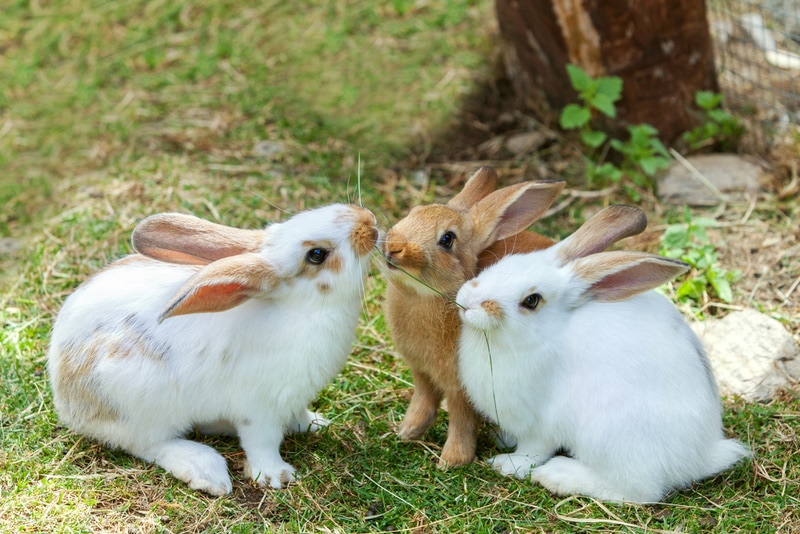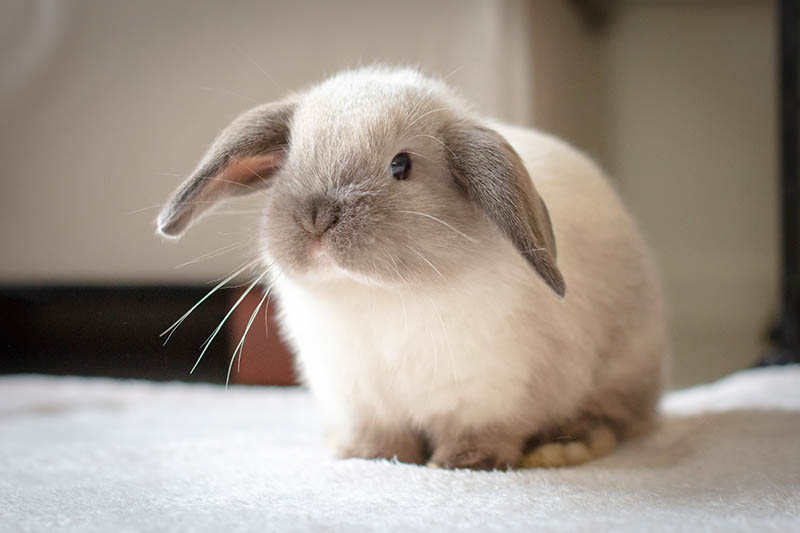Silver Rabbit: Pictures, Breed Care Guide, Lifespan & Traits
By Beth Crane
Updated on
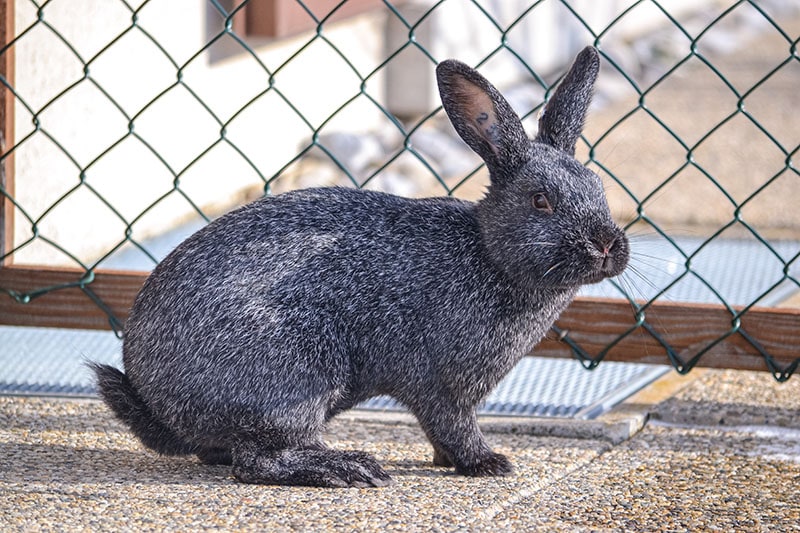
Click to Skip Ahead
The Silver rabbit is one of the oldest domesticated rabbit breeds in the world. They’re also incredibly rare; Silver rabbits are considered a heritage breed by the American Livestock Breed Conservancy due to their influence on rabbit domestication and decreasing numbers. No rabbit is quite like the Silver, and you can keep reading to discover more about what makes this breed so special.
| Size: | Medium |
| Weight: | 4–7 lbs |
| Lifespan: | 5–12 years |
| Similar Breeds: | Silver Marten, Silver Fox, Chinchilla |
| Suitable for: | Novice or experienced rabbit owners, owners with time to spend outside with their rabbit, and those with an interest in rare and heritage breeds |
| Temperament: | Energetic, active, docile, friendly |
The Silver rabbit is a rare but beloved breed in the United States and the United Kingdom. Despite its name, there are three colors of Silver rabbit recognized1 by the American Rabbit Breeders Association (ARBA): black, brown, and tan. Regardless of the color, all Silver rabbits have beautifully pearlescent white guard hairs that grow through the solid coat color as the rabbits age. The Silver rabbit is an ancient breed that has been around since at least the 1500s and has traveled from exotic countries to England, Australia, New Zealand, and finally, America.
Silver Breed Characteristics
How Much Do These Rabbits Cost?
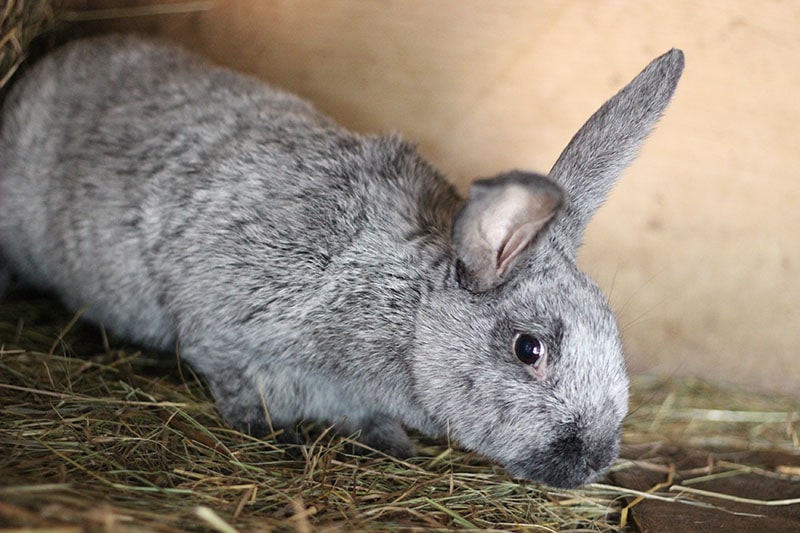
The Silver rabbit is such a rare breed that it has critical status as a heritage breed, meaning less than 50 individuals are registered annually in the US and that the global population is less than 50. Because of this incredible rarity, the prices can be higher than you usually pay for a pet rabbit. Depending on the pedigree, you can spend $50 to $100.
The beginnings of the Silver rabbit point to the wild and random genetic mutation of black rabbits in Europe, and its first tentative origins involve Sir Walter Raleigh. It’s thought that the Silver rabbits he imported from Portugal to England in 1592 were first imported from Siam, but this is impossible to verify. The Silver rabbit soon made its way across the globe, landing in America between 1778 and 1890. While incredibly rare, the Silver rabbit is recognized by the American Rabbit Breeders Association (ARBA) and the British Rabbit Council (BRC).
Temperament & Intelligence of the Silver
Silver rabbits, like all breeds of domestic rabbits, are intelligent and love to engage with their owners. They are known to be highly energetic and active as a breed, so you’ll need lots of space (both inside and outside) if you want to own one! They are friendly, not skittish, and docile towards their human owners if properly socialized. Like all rabbits, Silver rabbits don’t particularly like being picked up and are happier enjoying pets from their owners on their lap or lying beside them. Silver rabbits are trainable; most will easily learn basic skills like using a litter box and knowing their name!
Do These Rabbits Make Good Pets? 👪
Silver rabbits make good pets if their owners have enough outdoor space for them or time to take them outside. These rabbits thrive in the fresh air and need space to burn off some of their energy. Because they don’t like being picked up, Silver rabbits make good pets for school-aged children and older people who can respect their needs. Like all rabbits, the Silver rabbit needs a large space to free-roam in and dedicated interaction time. Because of their intelligence and active natures, Silver rabbits are the perfect candidates for training and competitive agility trials.
Does This Rabbit Get Along With Other Pets?
Silver rabbits are highly sociable and should always live with at least one other rabbit. With correct socialization, most Silver rabbits can live harmoniously with other well-socialized pets. However, “predator” animals like cats and dogs can stress rabbits, so a Silver rabbit will need a secure space to retreat to if they get overwhelmed. On the other hand, if cats and dogs are well-socialized with rabbits when they are young and don’t have a high chase or prey drive, they can live quite happily with each other and even form friendships. Despite this, rabbits should never be left alone with any other pets that aren’t rabbits (including smaller pets like rats or hamsters) due to the risk of injury.
Things to Know When Owning a Silver Rabbit :
Rabbits need specific accommodations as they are very different from other pets. They are prey animals, and the world looks very different to them than to pets like dogs and cats. By giving your Silver rabbit everything they need to be happy, healthy, and stress-free, you can enjoy their company for many years.
Food & Diet Requirements 🥕
Alongside fresh water being available 24/7, Silver rabbits need a diet rich in roughage and fiber to keep them healthy, as their bodies are designed to eat constantly! Rabbits are obligate herbivores, meaning they can’t eat any animal proteins and must get all their nutrition from plants. Because of that, a rabbit’s teeth and digestive system are specialized and are kept healthy by a suitable diet. Silver rabbits need a constant supply of high-quality hay to keep them healthy, which must be available 24/7.
Hay
Hay such as Timothy, alfalfa, or orchard hay should make up around 80-90% of a rabbit’s diet, and Timothy hay is the best kind to give adult rabbits. However, Silver rabbits older than 7 months old should only be given alfalfa hay if directed by your vet. The excess of calcium and protein in alfalfa can cause excessive and rapid weight gain in adult rabbits, but it should be fed to Silver rabbits under 7 months old to give them enough calcium and protein to help them grow.
An endless supply of hay is imperative to any rabbit’s health, as it helps the rabbit’s teeth and gastrointestinal system function. Silver rabbit’s teeth (like all lagomorphs) are open-rooted, meaning they never stop growing. Hay helps the rabbit’s teeth stay at the correct length, which is important to prevent overgrowth.
A rabbit’s gastrointestinal system is also kept moving regularly by hay, as the fiber helps to form the stool and soft caecotrophs that rabbits then ingest for added nutrients. Rabbits that don’t get enough hay in their diet can have runny stools, which can cause digestive upset, flystrike, or gut stasis (all of which can be fatal).
Veggies
The second largest part of your Silver rabbit’s diet should be leafy green vegetables. You can feed your Silver many types, including wild-grown (like dandelion leaves) and herbs. Adult rabbits should have around 2 cups of fresh leafy greens a day, and any that aren’t eaten should be discarded to avoid rotting. Suitable vegetables that can be given daily include:
- Bok choy
- Romaine lettuce
- Basil
- Cilantro
- Watercress
- Fennel
- Carrot Tops
Vegetables that can be given a few times a week include:
- Carrots
- Broccoli
- Collard Greens
- Kale
- Spinach
Make sure to introduce new vegetables slowly to your Silver since giving them new foods too quickly can cause diarrhea. Variety is the spice of life, so switch up the vegetables your rabbit is used to.
Pellets
Silver rabbits can also eat a small portion of hay-based rabbit pellets daily to ensure they get the correct nutrition. Around ¼ cup per five pounds of body weight is ideal, as feeding too many pellets can cause weight gain and digestive problems.
Fruits
As a treat, your Silver can eat small amounts of fruits. Fruit is particularly useful as a training aid, as most rabbits will do anything for a sliver of banana or a couple of berries! However, fruits are very high in sugar, so they should be restricted to approximately 1 teaspoon once or twice a week. Suitable fruits to give your Silver rabbit include:
- Banana
- Berries such as blueberries, raspberries, blackberries
- Melon
- Papaya
- Peach
- Bell Peppers
- Apple (with no seeds)
Habitat & Hutch Requirements 🏠
Silver rabbits are very active and need plenty of space to exercise in. All rabbits should have separate accommodations for sleeping and exercising, and no rabbits should solely live in a hutch or cage. The ideal living quarters for a Silver rabbit is a large cage inside the home, with a separate but connected large exercise area or rabbit-proofed room. Keep the living area away from other pets and draughts/direct sunlight and ensure it can be fully secured to prevent escapees.
Cage Size
Rabbits need a living space that’s big enough for them to:
- Lie completely flat without any part of them touching the sides
- Stand up without their ears touching the roof
- Hop four times inside in any direction
- Fully turn around in
These are the minimum requirements, and rabbits should always be given the biggest living space that space and money can allow. Aside from this space, you can install elevated platforms in their living area to strengthen their muscles and bones. A Silver rabbit’s living area should also have enough room for plenty of hay available at all times, a litter box, food and water bowls, and a gravity-fed water bottle (in case they have a preference!).
Ensure the floor of the living area is solid and easily cleaned to prevent sore hocks or pododermatitis. Plastic cages are ideal, and wire-sided cages are best to provide adequate ventilation. High-quality bedding, such as paper-based bedding, should be provided. The living area should be spot-cleaned once daily, and the entire enclosure must be completely emptied and cleaned with a rabbit-safe disinfectant at least once a week.
Exercise & Sleeping Needs 🐇
Ideally, an entire room can be dedicated to your Silver rabbits since they are so energetic and active, but a large secure pen can also work well. Silver rabbits also need plenty of toys and enrichment in their living quarters and exercise pens/rooms. They must exhibit their natural behaviors and stay healthy because wild rabbits spend nearly all their time foraging, eating, digging, and socializing!
When it’s finished exercising, your Silver will need a dark and comfy nestbox to sleep in. It can even be a simple cardboard box with a rabbit-sized hole cut out of the front and filled with hay!
Training 🥎
Rabbits are intelligent, and the Silver rabbit’s inquisitive and active nature means they’re a pleasure to teach. Most rabbits can easily be trained to come when called and use their litter box, but many learn tricks too! Learning to “turn around,” jumping over obstacles, and even competing in bunny agility courses are all possible for Silver rabbits. In addition, training a Silver to tolerate being handled or having their feet touched is incredibly useful for vet exams or nail clips.
Food is a great motivator for most rabbits, so using a favorite fruit treat often does the trick. However, rabbits are easily startled, and their attention spans aren’t the longest. It might take some time for your Silver rabbit to pick up a new command, but you shouldn’t get frustrated and shout at them, or they’ll become scared and refuse to interact with you.
Grooming ✂️
The Silver rabbit is short-haired, and grooming should be a once-a-week affair. Grooming your Silver’s fur once a week will keep it shining and in good condition, but make sure to use small animal grooming tools as rabbits have thin skin that tears easily. Most rabbits never need to be bathed as they are meticulous groomers, but you may have to gently soak their hind ends if they get poop or urine in their fur. Nail clips should be done at least once a month on your Silver rabbit, as long nails can impede movement and cause pain. Check your Silver’s fur and ears for redness and signs of parasites when you groom them since rabbits are susceptible to fleas and mites just like other pets!
Lifespan and Health Conditions 🏥
Silver rabbits are a healthy breed that has an average lifespan for rabbits (typically between seven and ten years), but well-cared-for rabbits often live until they are 12 or older! Like other rabbit breeds, the Silver rabbit is prone to some major and minor health conditions that are mostly due to poor husbandry or diet:
Parasitic Infection: Rabbits can get fleas and mites like other pets can, so your Silver will need preventative parasite treatments to keep their skin healthy. Topical treatments can be prescribed for rabbits by your vet.
Spinal Injuries: Rabbits are fragile and can easily break bones. Rabbits that are not exercised enough are particularly prone to spinal or limb injuries and fractures due to loss of bone density. Rabbits are highly muscular, so they can even break their spines or become paralyzed from kicking out with their hind legs!
Gut Stasis: Gut stasis is a severe condition caused by anorexia, pain, illness, or stress. The rabbits’ digestive system contains a delicate balance of bacteria that work together to ferment food properly and produce poop. When a rabbit eats less, eats too much of the wrong foods (e,g. not enough roughage), or stops eating altogether, this bacteria becomes unbalanced, and “bad” bacteria can build up. This bacteria can cause a painful build-up of gasses in the gut, making the rabbit eat even less. They can also release toxins into the rabbit’s body leading to full-body infection. Signs of gut stasis include:
- Not wanting to move
- Teeth grinding
- Collapse
- Not producing poop/ reduced poop production
- Anorexia
- Hunching in pain
Dental Problems: Genetic factors, injury to the mouth or teeth, or poor diet can cause dental problems in rabbits. If rabbits’ teeth are allowed to overgrow (usually due to a poor diet lacking in hay), they won’t be able to grind against each other and be worn down. Hay wears down the rabbit’s back teeth, which can grow painful spurs that extend into the rabbit’s cheeks. Rabbits incisors can also overgrow due to poor diet or malocclusion (where the teeth don’t meet as they should) and can grow behind the eyes, causing vision problems and abscesses.
FlyStrike: Flystrike (or myiasis) is a very painful condition that occurs due to flies laying their eggs on a rabbit’s skin, commonly in an open wound. The fly eggs hatch into maggots that consume the rabbit’s flesh, eating it alive. This condition requires urgent veterinary treatment as it is immensely painful and can quickly become fatal. The signs of flystrike in rabbits include:
- Wet fur/fur loss
- Pain
- Maggots present on or under the skin
- Swelling or movement under the skin
- A foul smell
You should check your Silver rabbits’ back and bottom daily for signs of fly strike, even if they are indoors. There are treatments available that can help reduce the risk of flystrike, but daily checking and good cleanliness are vital to preventing it.
Male vs Female
There is very little difference between male and female Silver rabbits, and they grow to around the same size. Female rabbits can develop a dewlap, an extra flap of skin and fat around their neck for nest-making and baby-rearing. However, some males can also develop one too!
3 Little-Known Facts About Silver Rabbits
1. Only Three Colors of Silver Rabbits Are Accepted by ARBA (Grey, Fawn, And Brown), but the BRC Also Recognizes Blue!
2. In the 1500s, The Largest Silver Rabbit Collection Was in Lincolnshire, England.
3. The Silver Rabbit Is Known by Many Names, Including Silver Sprigs, Lincoln Silvers, and Riche.
Final Thoughts
Silver rabbits are an important part of domestic rabbit history in the UK and the US. They are friendly and docile pets with plenty of energy, and significant time and space are needed to keep them healthy and happy. The breed is at serious risk of disappearing, which many lovers of the bunny are trying to prevent. The Silver’s iridescent fur is its crowning glory, and the special heritage rabbit deserves more recognition than it has received.
Featured Image Credit to: Roselyne M, Shutterstoc

